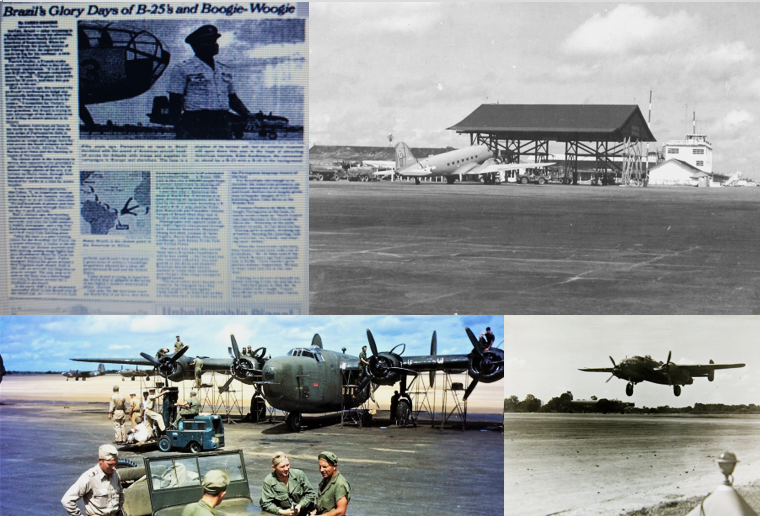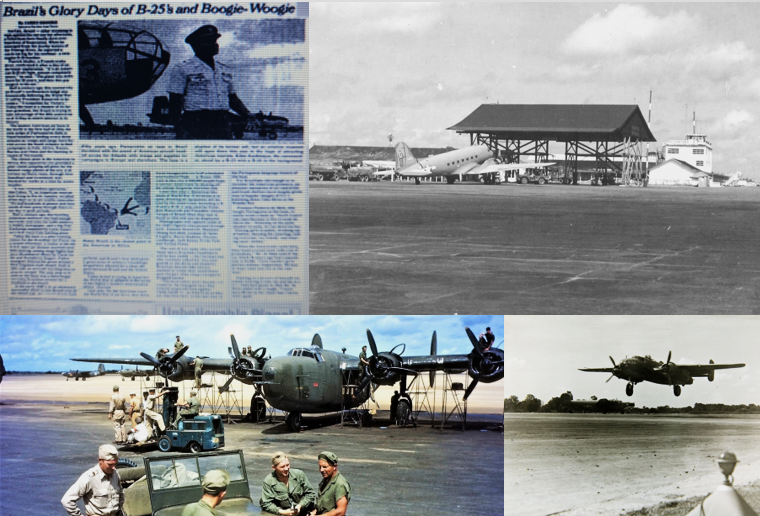
Por James Brooke – 26 de abril de 1994 – Fonte – https://www.nytimes.com/1994/04/26/world/natal-journal-brazil-s-glory-days-of-b-25-s-and-boogie-woogie.html
Depois de esticar em vão a rede numa tarde quente, um pescador finalmente mergulhou no mar, frustrado. Ao emergir das águas turvas do rio Potengi, ele relatou uma captura grande demais para seu barco a remo: um bombardeiro bimotor B-25.
Patrick Muller, um mergulhador francês, confirmou isso após um dia de exploração subaquática. “É um B-25 americano, quase completamente intacto”, disse ele. “O avião ficou lá embaixo por 50 anos, e então esse pescador o prendeu na rede.”
Há meio século, esta cidade costeira no nordeste do Brasil seguia freneticamente o apelo do presidente Roosevelt durante a Segunda Guerra Mundial para se tornar um “Trampolim para a Vitória”. Hoje a base é uma sombra de sua antiga grandeza, mas o Brasil tenta aproveitar o 50º aniversário do Dia D para renovar o interesse pela sua interessante história.
A base aérea americana mais movimentada do mundo na primeira metade de 1944, as faixas gêmeas do campo de Parnamirim, em Natal, realizavam um pouso a cada três minutos, enquanto tropas e cargas eram transportadas através do Atlântico Sul para alimentar campanhas na Itália, África, Rússia, Birmânia, China e a iminente invasão da Normandia.
O ponto mais próximo da África nas Américas, esta cidade equatorial proporcionou um ponto de partida durante todo o ano para os aviões de alcance limitado da época. Uma rota alternativa para o norte, através da Terra Nova e da Groenlândia, que ficava inoperante durante semanas devido ao inverno rigoroso nessas regiões.
“Foi uma operação tremenda”, lembrou Abe Cohen, 75 anos, um veterano americano que agora mora no Rio de Janeiro, sobre seus dias como controlador de tráfego aéreo. “Tínhamos centenas de aviões e milhares de homens passando por lá todos os dias nos períodos de pico”.
Há meio século, esta movimentada cidade militar americana tinha quartéis e tendas suficientes para 6.600 soldados, um jornal semanal e um grande Post Exchange fornecido pela primeira fábrica de engarrafamento da Coca-Cola da América Latina.
Hoje a base é centro de treinamento de pilotos da Força Aérea Brasileira. Numa tarde recente, um visitante do antigo teatro ao ar livre da USO assustou andorinhas que faziam ninhos entre as luzes do palco que outrora iluminavam espetáculos de Clark Gable e Humphrey Bogart. Mangas caídas cobriam a grama ao redor de uma capela no estilo da Nova Inglaterra, construída em 1943, com um farol de alerta de aeronave no topo do campanário. O único jipe avistado na base foi um buggy que transportava aviadores brasileiros para um fim de semana na praia.
No início da década de 1940, num esforço finalmente bem-sucedido para conquistar o Brasil para o lado Aliado, os Estados Unidos construíram aeródromos e a primeira siderúrgica do Brasil. Uma geração de amizades militares aqui forjadas permitiu uma estreita aliança entre o Brasil e os Estados Unidos.
Hoje o Brasil está tentando ressuscitar a aliança da Segunda Guerra Mundial em nome do nexo internacional moderno da região: o turismo.
No ano passado, pela primeira vez desde o encerramento do sistema de transporte aéreo da Segunda Guerra Mundial, Natal inaugurou o seu primeiro voo internacional regular – para Roma. As autoridades desta cidade de 650 mil habitantes esperam atrair os americanos, tirando a poeira da ligação quase esquecida durante a guerra.
Ainda este ano, será inaugurado um Museu Histórico da Aviação da Segunda Guerra Mundial, com base em equipamentos deixados pelos americanos, incluindo um B-23 e um B-25. Também será exibido um jipe usado pelo presidente Roosevelt e pelo presidente Getúlio Vargas do Brasil, quando se conheceram em Natal em 1943.
As fotografias irão capturar algumas das figuras da década de 1940 que por aqui passaram: Eleanor Roosevelt, Madame Chiang Kai-shek, Antoine de Saint-Exupéry, Harry Hopkins, Charles Lindbergh, Jack Benny, Ernie Pyle e Tyrone Power.
O elenco de espiões do Eixo que transformou Natal em uma Casablanca brasileira será menos visível – a freira alemã que rotineiramente passou por guardas nas docas e os obscuros fascistas brasileiros que sempre pareciam passar com suas motocicletas pelo porto quando os transportes de tropas ancoravam.
“A polícia local foi duramente criticada pela forma negligente como tratou os supostos agentes do Eixo”, escreveu Clyde Smith Jr., um professor americano que mora aqui e que no ano passado lançou um livro sobre a história da base em português.
Para os brasileiros com idade suficiente para se lembrarem da presença americana, as lembranças desagradáveis de exercícios antiaéreos e abrigos antiaéreos deram lugar, em grande parte, a imagens mais felizes de soldados derrubando Cuba Libres no Wonder Bar.
“Aprendi a dançar swing”, lembra Maria Lúcia da Costa, hoje bisavó, enquanto servia bolo caseiro a uma visitante americana. “O boogie-woogie foi ótimo. As festas americanas tinham de tudo”.
Seu marido, Fernando Hippolyto da Costa, coronel aposentado da Força Aérea Brasileira, entrou na conversa com uma lista de contribuições americanas à cultura local: “Óculos de sol Rayban, cigarros americanos, cerveja em lata, cabelos oleados e uso de shorts”.
Protasio Pinheiro de Melo, que ensinava português na base, escreveu recentemente um livro sobre “Contribuições norte-americanas para a vida do Rio Grande do Norte”. Relaxando em sua varanda à sombra de palmeiras, ele listou sua lista: “Beijar garotas em público, beber em garrafas, dançar jitterbug, chamar todo mundo de ‘meu amigo’ e usar roupas esportivas”.
“Quando os americanos chegaram aqui, encontraram uma cidade pequena com muitos preconceitos”, disse de Melo sobre Natal, que há 50 anos tinha uma população de 40 mil habitantes. “As meninas não podiam ir a festas sem acompanhantes. Tínhamos que usar paletó e gravata no cinema.”
Apontando para uma foto sua vestindo solenemente paletó, gravata e chapéu em um jogo de vôlei de soldados em 1943, Melo acrescentou rindo: “Devo ter 80 gravatas no armário que nunca mais usei”.
Uma versão deste artigo aparece impressa em 26 de abril de 1994, Seção A, página 4 da edição Nacional com a manchete: “Dias de Glória dos B-25’s e Boogie-Woogie do Brasil”

